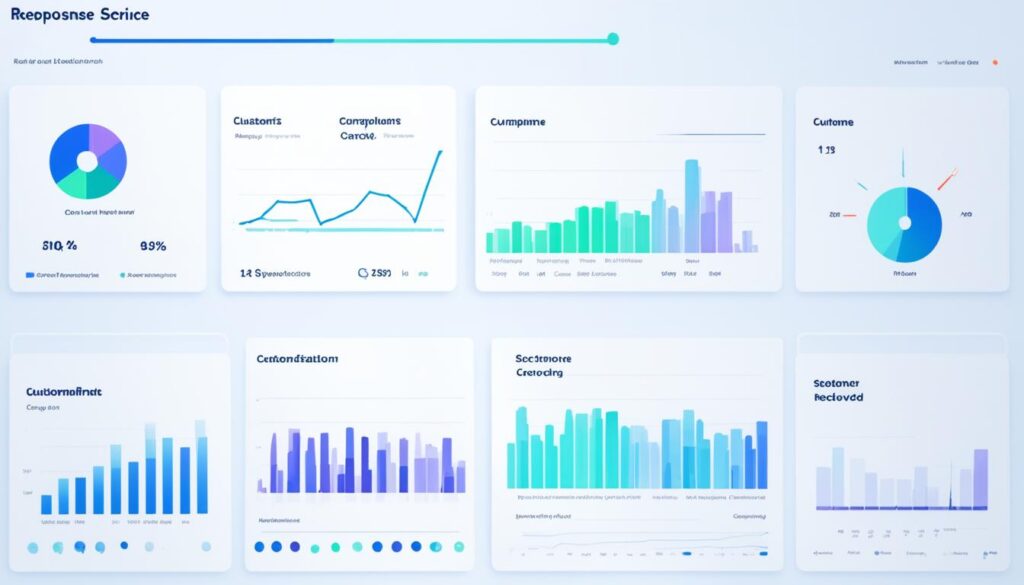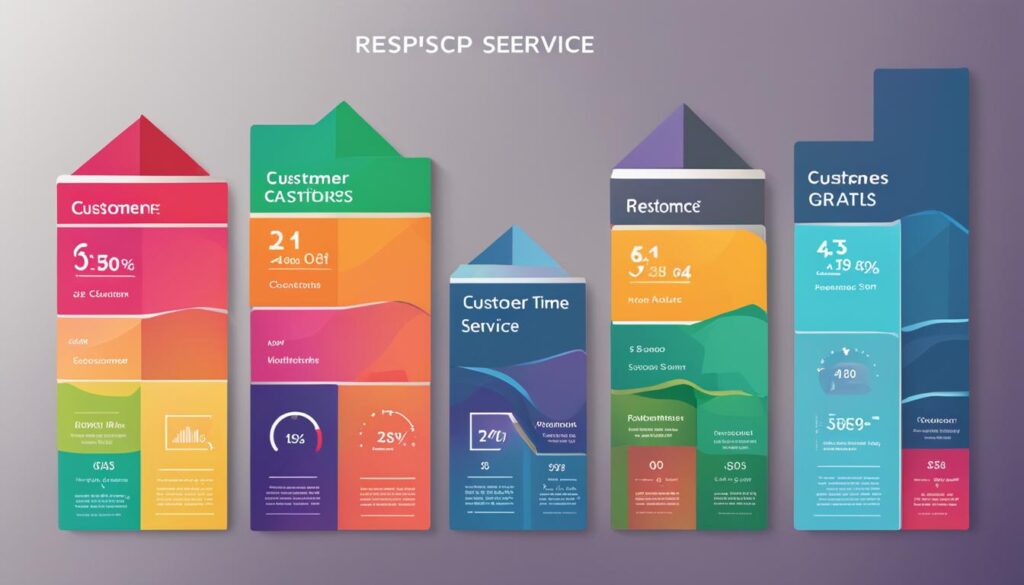Customer service excellence is a vital aspect of any business. It directly impacts customer satisfaction, which in turn influences customer loyalty. But how do you measure customer service excellence? Is it simply about customer satisfaction and experience? Is there a more effective way to gauge your performance in this crucial area?
In this article, we will delve into the world of measuring customer service excellence and explore key performance indicators (KPIs) that can help you track and evaluate your customer service performance. By understanding the metrics that matter, you can take a customer-centric approach and make data-driven decisions to enhance your overall customer experience.
So, are you ready to uncover the secrets of measuring customer service excellence? Let’s dive in!
Key Performance Indicators for Customer Service Excellence
Key performance indicators (KPIs) are essential for measuring customer service excellence. They provide valuable insights into how well a company’s customer service team is performing. By monitoring these KPIs, businesses can evaluate their customer service performance and make data-driven decisions to improve the overall customer experience.
First Response Time
The first response time is a crucial KPI that measures the time it takes for the customer service team to respond to customer inquiries or issues. A quick response demonstrates a commitment to prompt customer service and enhances customer satisfaction.
Average Resolution Time
The average resolution time measures how long it takes for the customer service team to resolve customer issues or complaints. A shorter average resolution time indicates efficient problem-solving and contributes to improved customer satisfaction.
Customer Satisfaction
Customer satisfaction is one of the most important KPIs for measuring customer service excellence. It gauges how satisfied customers are with their overall experience with the company’s customer service. Positive customer satisfaction scores indicate that customers are happy with the service they received, promoting customer loyalty and repeat business.
Customer Loyalty
Customer loyalty is another crucial KPI that measures how loyal customers are to the company and its products or services. Repeat purchases, positive reviews, and referrals are indicators of strong customer loyalty, which can be influenced by excellent customer service.
Net Promoter Score
The Net Promoter Score (NPS) is a widely recognized KPI that measures the likelihood of customers recommending the company to others. It provides insights into customer advocacy and the overall perception of the company’s customer service performance.
| KPI | Description |
|---|---|
| First Response Time | Measures the time taken to respond to customer inquiries |
| Average Resolution Time | Measures the time taken to resolve customer issues |
| Customer Satisfaction | Gauges overall customer satisfaction with the customer service experience |
| Customer Loyalty | Measures the level of customer loyalty and repeat business |
| Net Promoter Score | Measures the likelihood of customers recommending the company |
By focusing on these key performance indicators, businesses can proactively monitor their customer service performance, identify areas for improvement, and ensure customer satisfaction remains at the heart of their operations.

Choosing the Right Metrics for Your Business
When it comes to measuring customer service excellence, it’s crucial for businesses to choose the right metrics that align with their goals and provide meaningful insights into performance. Selecting appropriate customer service metrics requires consideration of various factors, including the size and location of your business, the stage of your business and customer lifecycle, and any unique circumstances specific to your industry.
Metrics should be relevant and have a direct impact on your business. They should be measurable and easy to track, allowing you to consistently monitor performance. Additionally, it’s essential for these metrics to be understandable to everyone in your organization, fostering a customer-centric approach throughout the company.
By focusing on the following considerations, you can effectively choose the right metrics and measure customer service excellence:
- Business Goals: Define your short and long-term objectives. Are you aiming to improve customer satisfaction, increase customer retention, or enhance overall customer experience? Your metrics should directly align with these goals.
- Performance Measurement: Determine the key aspects of your customer service that you want to measure. This may include response time, resolution rate, customer satisfaction scores, or customer loyalty indicators.
- Customer Lifecycle: Understand the different stages of your customer lifecycle, from initial contact to ongoing support. Tailor your metrics to reflect the specific needs and expectations of customers at each stage.
By carefully choosing metrics that align with your business goals and customer lifecycle, you can effectively measure and improve your customer service excellence. These metrics will provide valuable insights into where improvements can be made, allowing you to enhance customer satisfaction, loyalty, and overall business performance.

| Metric | Description |
|---|---|
| First Response Time | The average time it takes for a customer inquiry or request to receive an initial response from your customer service team. |
| Average Resolution Time | The average time it takes for a customer issue to be resolved from the moment it is reported. |
| Customer Satisfaction | The measurement of how satisfied your customers are with the service they receive. |
| Customer Retention Rate | The percentage of customers who continue to do business with your company over a specific period. |
| Net Promoter Score (NPS) | A metric that quantifies customer loyalty and advocacy based on the likelihood of customers recommending your business to others. |
| Complaint Escalation Rate | The percentage of customer complaints that are escalated to a higher level within your organization. |
These metrics provide key insights into your customer service performance and should form the core of your measurement strategy. By regularly tracking these metrics and making data-driven improvements, you can continually enhance your customer service excellence and drive business success.
The Importance of Customer Service Metrics
Customer service metrics play a critical role in tracking the customer experience and driving business performance. Research has shown a direct link between customer service and business success, making it essential for companies to prioritize this aspect of their operations.
Measuring key metrics such as customer satisfaction, net promoter score, and customer churn provides valuable insights into customer loyalty and the overall health of a business. These metrics help businesses identify areas for improvement, address customer pain points, and enhance the overall customer experience. By focusing on these metrics, companies can proactively meet customer expectations and build lasting relationships.
Moreover, customer service metrics are instrumental in understanding the impact of sales and marketing initiatives. They help businesses allocate resources effectively to drive customer satisfaction and loyalty. By measuring the right metrics, companies can track the success of their strategies and make data-driven decisions.
Ultimately, the effective use of customer service metrics has a direct impact on the bottom line of a business. By ensuring exceptional customer experiences and fostering customer loyalty, businesses can drive revenue growth and long-term success.

Tools for Measuring Customer Service Metrics
When it comes to measuring customer service metrics, there are several tools available that can help your business effectively track and evaluate its performance. These tools provide valuable insights into customer interactions, feedback, and sentiment, allowing you to make data-driven decisions and improve your customer service excellence.
Customer Relationship Management (CRM) Software
One of the most powerful tools for measuring customer service metrics is customer relationship management (CRM) software. CRM software provides a centralized platform for storing and analyzing customer data, enabling you to track and monitor customer interactions, measure key metrics, and gain a comprehensive understanding of your customer base. With CRM software, you can easily access important customer information, such as contact details, purchase history, and interactions, to provide personalized and efficient customer service.
Survey Tools
Gathering customer feedback is essential for measuring customer service metrics such as customer satisfaction and customer effort score. Survey tools allow you to create and distribute surveys to your customers, collecting valuable insights that can help you identify areas for improvement. By understanding your customers’ needs, preferences, and pain points, you can tailor your customer service strategies to meet their expectations and enhance their experience.
Social Media Monitoring Tools
Social media has become an integral part of the customer service landscape, with customers often turning to social platforms to voice their opinions and experiences. Social media monitoring tools enable you to track brand mentions, monitor customer sentiment, and gather feedback from social media platforms. By actively listening and engaging with customers on social media, you can address issues in real-time, proactively manage your online reputation, and connect with your customers on a more personal level.
Incorporating these customer service tools into your business operations can provide you with valuable insights, helping you track performance metrics, collect and analyze customer feedback, and make informed decisions to improve your customer service excellence.
Conclusion
Measuring customer service excellence is crucial for businesses to ensure customer satisfaction, loyalty, and ultimately, business success. By utilizing key performance indicators (KPIs) such as first response time, average resolution time, customer satisfaction, customer retention rate, net promoter score, and complaint escalation rate, companies can gain valuable insights into their customer service performance.
Monitoring these metrics and selecting the right ones for your business allows you to assess your customer service excellence, identify areas for improvement, and make data-driven decisions to enhance the overall customer experience. Furthermore, leveraging tools such as CRM software, survey tools, and social media monitoring tools can significantly aid in effectively tracking and measuring your customer service metrics.
Continuous monitoring and improvement of customer service excellence not only differentiate your business from competitors but also help to build strong customer relationships and drive long-term success. With a customer-centric approach and a focus on optimizing these key metrics, you can ensure that your customers are satisfied, loyal, and more likely to contribute to the growth and success of your business.
FAQ
How important is customer service excellence for businesses?
Customer service excellence is crucial for businesses as it directly affects customer satisfaction and loyalty. According to a McKinsey study, 70% of purchase decisions are influenced by customer service. Furthermore, improving customer retention by just 5% can lead to a significant increase in profits.
What are some key performance indicators (KPIs) for measuring customer service?
Key performance indicators (KPIs) for measuring customer service include first response time, average resolution time, customer satisfaction, customer retention rate, net promoter score, and complaint escalation rate. These metrics help businesses track and evaluate their customer service performance.
How can businesses choose the right metrics for measuring customer service excellence?
When choosing metrics for measuring customer service excellence, businesses should consider factors such as the size and location of their business, the stage of their business and customer lifecycle, their short and long-term goals, and any unique circumstances that are specific to their business. Metrics should be relevant, have a direct impact on the business, be measurable and easy to track, and be understandable to everyone in the organization.
Why are customer service metrics important?
Customer service metrics provide valuable insights into the customer experience and drive business performance. Metrics such as customer satisfaction, net promoter score, and customer churn help businesses identify areas for improvement, address customer pain points, and enhance the overall customer experience. Additionally, metrics help businesses understand the impact of their sales and marketing initiatives and ensure that resources are allocated effectively to drive customer satisfaction and loyalty.
What tools are available for measuring customer service metrics?
There are several tools available to help businesses measure customer service metrics effectively. Customer relationship management (CRM) software provides a central platform for storing and analyzing customer data, allowing businesses to track and monitor customer interactions and measure key metrics. Survey tools enable businesses to gather customer feedback through surveys, allowing them to measure metrics such as customer satisfaction and customer effort score. Social media monitoring tools help businesses track brand mentions, monitor customer sentiment, and gather feedback from social media platforms.
How can measuring customer service excellence impact business success?
Measuring customer service excellence is crucial for businesses to ensure customer satisfaction, loyalty, and business success. By monitoring key performance indicators (KPIs) and making necessary improvements, companies can assess their customer service excellence, identify areas for improvement, and enhance the overall customer experience. By continuously monitoring and improving customer service excellence, businesses can differentiate themselves from competitors, build strong customer relationships, and drive long-term success.
